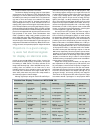
based on DLP with a native resolution of 1280 x 720 pixels
(16.9). Hitachi and Mitsubishi have signed agreements to
develop consumer HDTVs based on this technology for sale in
late 2000. The image quality of the prototype was, to my eyes,
excellent. If the consumer versions can match it, and do so
affordably, we may not have reason to mourn the passing of
CRT for long.
Given the arrival of HDTV and the ramp-up of HDTV pro-
gramming over the next few years, there is little reason to
consider buying an LCD or DLP projector today with less than
XGA resolution. The gain in detail on high-definition images
with XGA is, in my opinion, well worth the typical 30 percent
price increase over comparably equipped SVGA models. If the
price can be justified, SXGA (1280 x 1024) projectors are, of
course, much better, but are currently available only with
LCD technology. Several notable models of LCD projectors
with SXGA resolution were introduced at the show, including
S a n y o ’s PLC-EF10N and Barco’s BarcoReality 6300DLC.
While neither would be my first choice for a home theater,
they are significant in one respect: They both include a form
of digital video connection. Such a connection bypasses the
traditional conversion steps between analog and digital most
video signals must take between the video source and the dis-
play. A digital connection provides the cleanest possible way
to send the signal and, as importantly, eliminates a lot of the
fussy set-up issues involved with getting an image to look
good. The Sanyo projector provides a digital connection
called “PanelLink,” which is becoming a standard way to con-
nect computers to flat-panel monitors. The Barco product
provides an optional FireWire connection. FireWire (IEEE
1394) is the standard that will very likely be used to connect
consumer DTV products together, from HDTVs to digital
VCRs to surround processors. The important point is this:
What is available on these professional projectors now will
become available on consumer projectors, in one form or
another, soon.
The trend to digital connectivity is not just restricted to
projectors. Plasma display panels (PDPs) are getting in on
the act, too. A prime example introduced at the show is the
Revox E-542. Advertised as the world’s thinnest PDP, at a 2-
inch depth, it consigns all user-connections to an external
box that sends digital video signals and power to the display
over a single cable up to 40’ long. The control box has a slot
to accept a FireWire interface card to be developed later
this summer.
Speaking of PDPs, they were definitely one of the hot
technologies at the show. They are being increasingly con-
sidered for use in corporate boardrooms and for point-of-sale
displays. In the consumer world, more and more people are
considering them worthy alternatives to large direct-view
CRT monitors and rear-projection units for home theater.
The more affordable panels are those with “standard” resolu-
tion – 852 x 480 at 16.9 aspect ratio. The most recent of these
at the show had better contrast ratios, higher brightness, and
more accurate colors than last year’s models. Nevertheless,
they weren’t turning heads the way their high-definition sib-
lings were. Last year, only one high-definition PDP was intro-
duced at the show. This year, five were introduced, which is
a good indication of the way this technology may be matur-
ing. NEC’s PlasmaSync 5000W was the standout. This 50”
diagonal 16.9 panel, with a resolution of 1365 x 768, had the
best looking image I’ve seen yet from a PDP.
While PDPs are unquestionably getting better, they still
have problems. One of the more notable is a tendency to pro-
duce noise in dark areas of the image. The only panel I saw
not showing this noise – the Revox E-542 – had obvious con-
touring (discrete steps in the grayscale) in the dark regions of
the picture, leading me to suspect that the noise may be an
intentional trade-off to reduce the visibility of contouring.
PDPs also tend to show rather obvious deinterlacing and
resizing artifacts, although this may simply be a function of
the image processing electronics rather than a property of
PDP technology itself.
An Ideal Cinema?
This report wouldn’t be complete without mentioning a land-
mark event at this year’s show. Hughes-JVC and Miramax
Films teamed up to give show attendees a “digital sneak pre-
view” of Miramax’s An Ideal Husband before its release on
film. Shown in its entirety, the movie was projected onto a
t h e a t e r-sized screen by a Hughes-JVC ILA-12K projector.
“ILA” stands for Image Light Amplification and is Hughes-
J V C ’s answer to the problem of projecting a high resolution
electronic image with extremely high brightness. Digital
Light Processing (DLP) is the competing answer from Te x a s
Instruments. While the image I saw from the Hughes-JVC pro-
jector was not perfect, the resolution, color saturation, and
contrast were all good enough to give me confidence that
electronic projection – whether based on ILA or DLP tech-
nology – will be equal to the task when digital cinema
becomes an every-day reality. When that day arrives, the
technologies exhibited each year at Infocomm will have
found their ultimate expression.
chroma transitions. Barco’s VSE-20 line doubler, Extron’s
DVS-100 scaler, and RGB Spectrum’s DTQ scaler all earned
a “poor” rating, mostly because of their inability to cleanly
handle VCR playback (particularly in the case of the DTQ).
If VCR playback is discounted, they each earn a rating of
“adequate.” In the 64 kHz category, I considered only one
product “good,” the Communication Specialties Deuce Pro.
I rated Analog Way’s Smart Cut II scaler “adequate”
because of some instability during VCR preview modes
and because of relatively poor high-frequency luma
response. Extron’s Sentosaxi earned a “poor” rating
because of a considerable number of obvious deinterlacing
artifacts. I likewise rated Focus Enhancement’s QuadScan
“poor,” in this case mostly because of its unstable
response to VCR playback – the image was not steady
even during regular play. If this is ignored, its overall perfor-
mance is adequate. Lastly, Barco’s VSE-40 also earned a
rating of “poor” because of its relatively poor high-frequen-
cy luma response combined with an excessively noisy pic-
ture.
This comparison of upconverters should be ta k en with
caution because the source material and conditions
imposed by the Shoot-Out were too limited to evaluate the
p e r f ormance of the products thoroughly. If yo u ’re in the
m a r k et for an upconve r t e r, try to audition the products yo u r-
self using test material and sources you are intimately
familiar with. A K
For t he first t ime, t he Shoot -
Out
included a high-def init ion


















